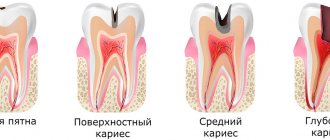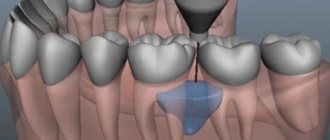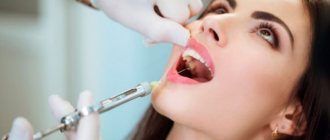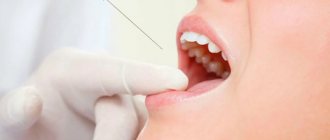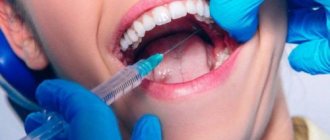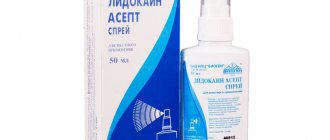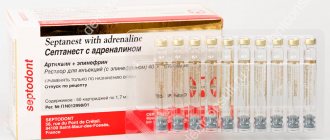Anesthesia without adrenaline has been used in dentistry for quite a long time; it allows painless treatment even for those patients who have contraindications to common means of local anesthesia. Typically, drugs that do not contain adrenaline are used in cases where it is necessary to treat teeth in patients with high blood pressure, heart disease, and pregnant or breastfeeding women.
Local anesthetics
Local anesthetics in dentistry include such well-known drugs as novocaine and lidocaine, as well as more powerful long-acting agents such as bupivacaine and etidocaine.
Typically, anesthetics are administered with adrenaline, since it significantly enhances the analgesic effect and increases the duration of anesthesia, but sometimes adrenaline is harmful (for example, it can provoke a panic attack). Anesthetics in dentistry without adrenaline (Ultracain D.S., Scandonest and others) are used in the following cases:
- with high blood pressure, tachycardia, arrhythmia, heart and vascular diseases, with VSD;
- with very strong anxiety (it is better to frankly admit this to the doctor, then, most likely, he will select an anesthetic without adrenaline);
- in women - during pregnancy, during PMS, during painful menstruation and menopause;
- as an alternative to conventional anesthetics (if you are allergic to them).
Features of anesthesia for pregnant and nursing mothers in dentistry
Pregnant women definitely need to have their teeth treated, because caries or other inflammatory processes in this area are a threat to the health of the baby. Treatment with special anesthesia, tooth extraction, removal of plaque and stone, and rinsing according to doctor’s indications are allowed. Implantation, x-rays, the use of dental gels and ointments without medical advice, and the unauthorized use of antibiotics and painkillers without a doctor’s prescription are prohibited. Prosthetics and orthodontic treatment during pregnancy are questionable. Various complications and inflammations may occur, which are especially dangerous during this period.
The second trimester is the most favorable for dental treatment - there is no toxicosis, the formation of the main organs and systems of the fetus is behind. If you suffer from toothache, there is no need to postpone treatment at any time during pregnancy; the doctor will select a special anesthesia. Pregnant women often have gingivitis (inflammation and bleeding of the gums, severe sensitivity), which must be treated. Without treatment, the risk of premature birth increases up to 6 times. In the last trimester, dental treatment is especially dangerous; any stress can trigger labor before term.
Anesthesia in dentistry during pregnancy is characterized by the use of anesthetics without adrenaline (it can cause uterine hypertonicity). Articaine drugs are used, for example, primacaine and ultracaine. These substances do not penetrate the placenta, but at the same time they provide excellent pain relief, soothe inflammation of the oral cavity, and are hypoallergenic. Similar anesthesia in dentistry is also used during breastfeeding.
ZAKS
The use of nitrous oxide (or laughing gas) is an ancient (used since 1844) and very effective method of pain relief, which has been adopted by the most modern clinics. Inhaling small amounts of nitrous oxide mixed with oxygen causes mild euphoria and has a relaxing and pain-relieving effect (called sedation). Nitrous oxide sedation is absolutely harmless, acts almost instantly, and recovery from it takes 10–15 minutes without any consequences.
Indications:
- fear and anxiety before treatment;
- young age of patients (most often ZAX is used for children);
- long-term treatment (for example, many teeth are removed at once);
- pronounced gag reflex, profuse salivation.
Contraindications:
- age under 3 years;
- severe intoxication, chronic alcoholism;
- mental disorders, severe neurological diseases;
- sensitivity to individual components of the mixture;
- very strong excitement before upcoming dental procedures, hyperexcitability or hysteria (in children);
- 1st trimester of pregnancy;
- use ZAX with extreme caution in case of high blood pressure, previous concussion and other head injuries;
- Serious respiratory tract infections (asthma, bronchitis) may be a contraindication to sedation.
ZAX does not exclude the use of conventional anesthetics. There is no need to prepare for ZAX in any specific way, but 2 hours before the procedure it is highly advisable to refuse any food (you can drink). On the day of sedation, it is better to take a day off from work and not drive. Children are advised to refrain from active games for 1-2 hours after sedation.
Articaine with adrenaline
Symptoms of overdose
From the central nervous system
Excitation of the central nervous system: feelings of anxiety, fear, confusion, hyperpnea, tachycardia, increased blood pressure with facial flushing, nausea, vomiting, tremor, twitching, tonic-clonic convulsions.
Central nervous system depression: dizziness, hearing impairment, loss of ability to speak, stupor, unconsciousness, atony, vasomotor nerve paralysis (weakness, pallor), shortness of breath, death from respiratory paralysis.
From the cardiovascular system
Bradycardia, arrhythmia, ventricular fibrillation, drop in blood pressure, cyanosis, cardiac arrest.
Treatment
At the first signs of intoxication or side effects of the drug, such as dizziness, motor agitation or stupor during drug administration, its administration should be stopped and the patient should be transferred to a horizontal position with the lower limbs raised. The airway should be maintained and hemodynamic parameters (heart rate and blood pressure) monitored. It is always recommended, even if the symptoms of intoxication seem mild, to free access to the veins in order to be able to immediately administer the necessary medications intravenously, if necessary.
In case of breathing problems, depending on their severity, oxygen supply is recommended, and if there are indications for artificial respiration, endotracheal intubation and artificial ventilation of the lungs are recommended.
Muscle twitching and generalized cramps can be stopped by intravenous administration of a fast-acting drug that relieves muscle spasms (for example, diazepam, suxamethonium chloride). Mechanical ventilation (oxygen supply) is also recommended.
A sharp decrease in blood pressure, bradycardia or tachycardia can often be corrected by simply moving the patient to a horizontal position with the lower limbs elevated.
In case of severe circulatory disorders and shock, regardless of their cause, the drug should be discontinued and the patient should be transferred to a horizontal position with the lower limbs elevated. Oxygen should be supplied, intravenous administration of electrolyte solutions, glucocorticosteroids (for example, 250 - 1000 mg of prednisolone or an equivalent amount of its derivative, for example, methylprednisolone), infusion replacement therapy (if necessary, additionally, plasma substitute, human albumin).
With the development of collapse and increased bradycardia, epinephrine (adrenaline) is immediately administered intravenously. After diluting 1 ml of a 0.1% epinephrine solution (1:1000) to 10 ml, using the resulting 0.01% epinephrine solution (1:10000), slowly intravenously administer 0.25-1 ml (0.025-0.1 mg epinephrine), controlling heart rate and blood pressure (caution: heart rhythm disturbances are possible!).
Do not exceed a single intravenous dose of 1 ml (0.1 mg epinephrine).
If subsequent doses greater than 0.1 mg are required, epinephrine should be administered by infusion, adjusting the rate of administration while monitoring heart rate and blood pressure.
Severe tachycardia and tachyarrhythmia can be treated with antiarrhythmic drugs, excluding non-selective beta-blockers, such as propranolol. In such cases, oxygen supply and control of the circulatory system are necessary. The increase in blood pressure in patients with arterial hypertension, if necessary, is relieved with the help of peripheral vasodilators.
General anesthesia
General anesthesia is a last resort when other methods of pain relief are ineffective. When is general anesthesia used for dental treatment:
- serious surgical interventions (for example, in acute or chronic osteomyelitis, multiple tooth extractions);
- if the patient suffers from dental phobia and there is no other way to cure teeth except to go into medicated sleep;
- if the patient (child or adult) suffers from cerebral palsy, autism, Down syndrome, or other serious mental disorders;
- pronounced gag reflex or extremely profuse drooling;
- allergy to local anesthesia, inability to select suitable drugs.
Contraindications:
- serious heart disease, high blood pressure;
- severe respiratory diseases.
You will first need to take a general blood test and an ECG, as well as consult an anesthesiologist and dentist.
General anesthesia in dentistry
Sedation is used for general anesthesia in dentistry. What it is? Sedation is a drug-induced sleep during which all reflexes are preserved, the patient can turn his head and open his mouth wider. If necessary, it can be quickly removed from this state. During sedation, a large number of teeth can be treated without discomfort. An anesthesiologist is constantly in the office; pulse, blood pressure, ECG, and blood oxygen saturation are monitored. After the operation, the patient feels only slight drowsiness and relaxation, there is no pain. This method is optimal in the presence of severe fear, hypertension, allergies to any type of anesthesia, and is suitable for children.
How to increase the effectiveness of anesthesia
Following a few very simple rules will significantly increase the effectiveness of anesthesia and help make dental treatment as painless as possible:
- If you are very nervous, 3-4 days before your visit to the doctor, you can drink mild sedatives: persen, valerian, motherwort. Severe anxiety impairs the quality of anesthesia, since people under stress often have a lower pain threshold. As an alternative, you can ask for a sedative injection directly at the dental clinic - the doctors will definitely accommodate you.
- At least a day before visiting the dentist, you should completely avoid drinking alcohol, as alcohol seriously reduces the effectiveness of anesthesia.
- If you feel unwell, have a cold or runny nose, you should reschedule your visit. It is worth postponing a visit to the dentist and women in the midst of pronounced PMS or during the menstrual period.
The doctor selects a dental anesthetic individually, taking into account the health status and even the mood of each patient. Therefore, it is so important to tell your doctor frankly and in detail about your ailments and possible concerns.
Electronic anesthesia in dentistry
This is a technique of anesthesia in dentistry in which the rate of administration of the anesthetic is under electronic hardware control. The anesthetic is delivered dropwise, without injury or stress, the needle moves smoothly. The advantages of using an anesthesia device in dentistry are the absence of pain, fast response (two minutes for pain relief), complete patient comfort (no discomfort before, after, or during the process), and accuracy of the injection.
Dental Guru clinics use an innovative method of computer anesthesia using the MEG-INJECT device, which allows you to accurately calculate the dose of the drug and the speed of its delivery. A thin needle ensures painless injection; application anesthesia is not required before the injection.
Medicines
Since the implant installation procedure takes time, especially if the patient has a lack of bone tissue or other complications, the anesthetic must remain in effect throughout the entire work of the master. Today, the most actively used drugs are Ultracaine and Ubistezin, they are derivatives of articaine. The effect after their administration lasts up to 3 hours, usually this is enough to complete all manipulations.
Some people have a very strong fear of visiting the dental clinic, so local anesthesia alone may not be enough for them. Then the professional can decide to premedicate. What it is? This is a course of therapy developed individually, the drugs included in it are designed to calm and relax, and set you in a positive mood.
Such substances should be taken approximately a few days before the start of the surgical stage. Their selection is made on the basis of a preliminary examination and analysis. Commonly prescribed options: Seduxen, Valerian, Sibazol and Atropine. It is strictly forbidden to self-medicate; this can cause irreparable harm to the body and jeopardize the possibility of an already planned operation.
previous post
Classic dental implantation
next entry
Types of implants
Modern clinics use products from time-tested manufacturers who have proven themselves in practice and have many positive reviews. All implants can be divided into several types, each model is designed to solve specific problems, so the choice should be approached with maximum responsibility. The most common are root-shaped ones; in their shape and size they are most similar to a real tooth root. The risks of developing pathologies in this case are minimal, osseointegration occurs quickly.
Plate analogues are distinguished by the presence of a plate with small pores. They are designed to work with loose and thin bone tissue, when conventional technologies are simply powerless. They are usually placed in the smile area, since they are not able to withstand too much chewing load. In addition to lamellar ones, subperiosteal options are actively used, which are attached to the area between the soft tissues and the alveolar ridge.
Mini designs are created for those who have limitations in carrying out full implantation; they are only suitable for replacing one or two lost units. The choice of available products is very large, they all have their advantages and disadvantages, indications and contraindications. All options are characterized by excellent performance characteristics and can serve their owner for several decades.
